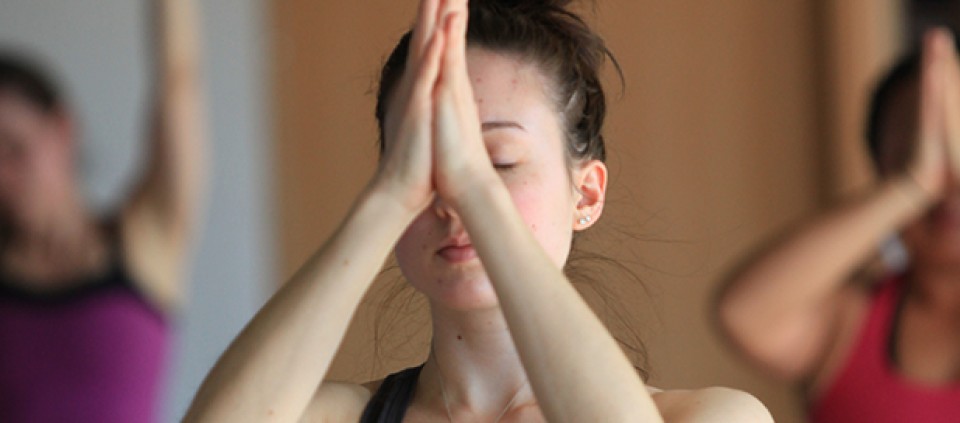A Different Kind of Vision: Seeing the Practice from the Inside

by Jennifer Lang
Over the past two decades, I’ve taken yoga classes in some far-flung places—Berlin, Lausanne, a tiny village in southern Thailand—as well as in Los Angeles, New York City, and Santa Fe, New Mexico. While every class was special in its own way, it was a Sunday morning vinyasa flow class in Philadelphia that was unforgettable for me.
It was a sticky July day and, by the time class started, we were mat to mat. Just as the teacher was about to speak, the door opened. Two people entered, one escorting the other, holding him by the elbow, telling him to step up and turn left. The teacher approached them and the sighted man spoke quietly to her, introduced his friend, then left. People behind me stood and repositioned their mats to make space for the newcomer. The teacher led the blind man to a designated mat. One woman got blocks and put them down on the floor.
“I put two blocks to the right,” she told him. I turned around to see him nod and thank her. He reached out to feel for the props. Once he was settled, the teacher returned to her spot. She guided us into a seated meditation with pranayama, and then instructed us to stand at the top of our mats.
All I could think about was the blind man. How was he going to follow? If he couldn’t see what was going on around him, how would he know what to do with his body—where to be in space, how to find alignment? What about his sense of balance.
We began warming up with a few Sun Salutations that got progressively faster. First Surya Namaskar A, then B. The teacher’s voice was calm and confident as she carefully enunciated each word.
“Stand in Mountain pose at the top of the mat,” she said. “Step your right leg back about three or four feet behind you and let the left side of your body roll to the right. On the inhale, straighten your legs and, on the exhale, shift your hips to the right and let your left arm reach out and down toward the left foot for Trikonasana, Triangle pose. Use your block under your bottom hand if you don’t reach.”
With a non-seeing student, the teacher had to be precise, concise, exact. She used both the Sanskrit and the English names of poses and offered at least two alignment cues for every pose—but it never felt like too much talking.
As we moved from Triangle into Balancing Half Moon, I glanced behind me to watch this young man balance on one hand and one leg, his body in an arc. Every few poses, I looked back at him. He was graceful and buoyant. I wondered whether he was a longtime practitioner, maybe even a yoga teacher, or just a quick study who could easily follow directions.
When class ended, I left the studio aglow and satisfied—physically, emotionally, spiritually. For the weeks and months following, I thought a lot about that man on the mat. How his practice might be more difficult physically, yet more authentic than most: Since he isn’t able to see what the teacher’s or his fellow practitioners’ poses look like, he can’t be in competition. When we compete with each other, we miss out on the essence of the practice, the turning in and finding our centers, ourselves.
Without our vision, our other senses are heightened. Eyes closed, I imagine hearing a room full of pranayama, my own breath becoming more audible and pulsing in my throat, chest, belly. If music is playing, I envision each note becoming a clue or a guide throughout the practice, like a conductor leading his orchestra. I imagine the smell of sour bare feet, stale breath, or salty body odor attacking my nasal passages. Or maybe, if lavender oil or jasmine incense is burning, sweetness permeates the air instead. Without our vision, we realize how important our center is to pull into, rely on, and stay aligned.
This experience has affected me as both a yoga practitioner and a yoga teacher. More than once, I’ve tried to close my eyes during my practice. While moving from Mountain to Forward Bend to Downward Dog, I flow freely. But when I try to balance with my eyes closed, I quiver and collapse, thankful for my ability to see.
I have often shared the story of the blind yogi with my students. Off and on throughout class, I instruct them to close their eyes, to tap into a different part of their brains to understand where their bodies are in space. I ask them to feel the poses from within—deep in the body, deep in the heart.
Jennifer Lang is a yoga instructor and writer living in Raanana, Israel, where she blogs about her adventures here.
© Kripalu Center for Yoga & Health. All rights reserved. To request permission to reprint, please e-mail editor@kripalu.org.